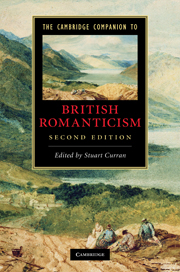Book contents
- Frontmatter
- 1 Romanticism and the “schools” of criticism and theory
- 2 Romanticism and Enlightenment
- 3 Poetry in an age of revolution
- 4 German Romantic Idealism
- 5 Romanticism and language
- 6 Culture’s medium: the role of the Review
- 7 Publishing and the provinces in Romantic-era Britain
- 8 Women readers, women writers
- 9 Romantic fiction
- 10 Romantic poetry: why and wherefore?
- 11 The sister arts in British Romanticism
- Guide to further reading
- Index
1 - Romanticism and the “schools” of criticism and theory
Published online by Cambridge University Press: 28 January 2011
- Frontmatter
- 1 Romanticism and the “schools” of criticism and theory
- 2 Romanticism and Enlightenment
- 3 Poetry in an age of revolution
- 4 German Romantic Idealism
- 5 Romanticism and language
- 6 Culture’s medium: the role of the Review
- 7 Publishing and the provinces in Romantic-era Britain
- 8 Women readers, women writers
- 9 Romantic fiction
- 10 Romantic poetry: why and wherefore?
- 11 The sister arts in British Romanticism
- Guide to further reading
- Index
Summary
For students of English literature from the 1780s through to the mid 1830s, “Romanticism” and the “Romantic period” are not what they used to be - one good reason for a second edition of this volume. To be sure, “Romanticism” as a literary movement or a complex of beliefs and styles of art, and “Romantic” as a descriptor of that type of writing or writer, have long referred to “being like romance”: to reworking an aesthetic mode, particularly the European quest-romance of the twelfth through the sixteenth centuries, where imagination, desire, and myth-making heighten what we usually take as perceived “reality” to extend its limits with symbolic suggestions that deepen, expand, or transcend everyday human awareness. Such a relocation of “romance,” in fact, was already in progress well before 1780. By then “romantic” as a signifier had already strayed from mainly describing supernatural tales of chivalry, including their expressions of love, parodied in Cervantes's Don Quixote (1605-15), to characterize the assertively “natural,” but also mythological and idealizing, landscape paintings of Claude Lorrain and Salvator Rosa from the seventeenth century as these came to Britain from southern France and northern Italy (to many, then, the “regions of romance”) to become exemplars of grand sublimity within the late eighteenth- century culture of “sensibility” (Eichner, 'Romantic,' p. 5).
- Type
- Chapter
- Information
- The Cambridge Companion to British Romanticism , pp. 1 - 33Publisher: Cambridge University PressPrint publication year: 2010
- 1
- Cited by



